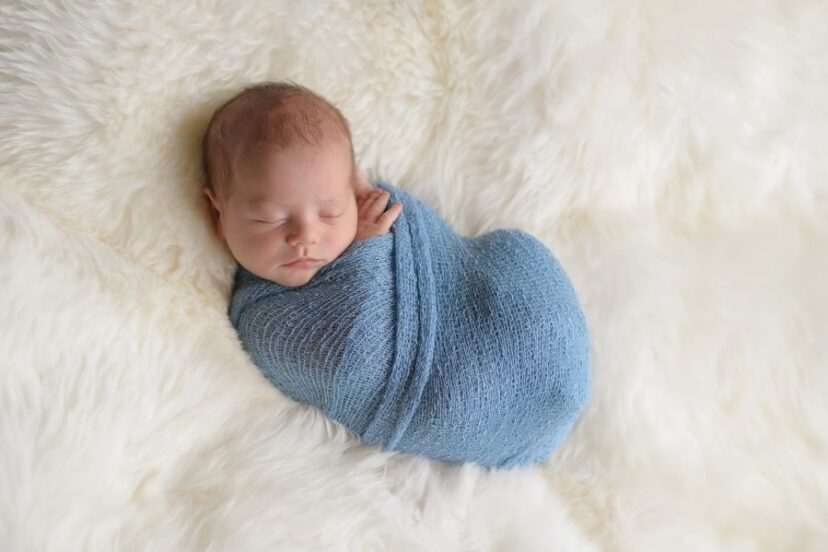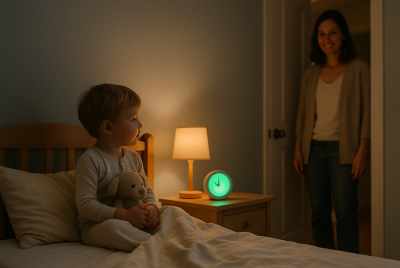Baby Won’t Sleep Without Swaddle but Rolls Over: What to Do?
We may earn a commission for purchases made using our links. Please see our disclosure to learn more.
Alright, fellow parents, gather ’round! We’re about to dive into the wild world of baby sleep—specifically, that tricky phase when your little bundle of joy is addicted to swaddling but suddenly decides to channel their inner gymnast. If you’re nodding along, thinking, “Yep, that’s my life right now,” then buckle up because we’re in for a rollercoaster ride!
Understanding the Swaddle
Let’s rewind a bit and chat about why swaddling is such a big deal. Imagine your baby, snug as a bug in a rug, wrapped up tighter than your favorite burrito. It’s like a warm, cozy hug that never ends—what’s not to love? Swaddling has been around since… well, probably since some exhausted caveman parent figured out that wrapping their baby in a mammoth skin helped them sleep better. It’s not just an old wives’ tale; there’s actual science behind why it works. Swaddling mimics that snug feeling of being in the womb. It’s like giving your baby the ultimate comfort zone!
Why Your Baby Loves to be Swaddled
Now, let me tell you about my little guy, Ollie. From day one, Ollie was a swaddle addict. The moment we wrapped him up, it was like flipping a switch—instant calm. It was almost magical, like we had some sort of baby whisperer superpower. But it’s not just about making them feel cozy. Swaddling is like kryptonite for that pesky startle reflex. You know, when your baby suddenly jerks awake, arms flailing like they’re conducting an invisible orchestra? Yeah, swaddling puts a stop to that nonsense real quick.
The Rolling Over Dilemma
So, there I was, thinking I had this parenting gig figured out. Ollie was sleeping like a champ in his swaddle, and I was finally getting more than two consecutive hours of sleep. Life was good. Then, BAM! One night, I peek into the crib, and there’s Ollie, face down, still wrapped up like a little burrito. Cue the panic mode! (I mean, we’ve all had “back is best” drilled into our heads, right?) Suddenly, our foolproof sleep solution had turned into a safety hazard. Talk about a parenting plot twist!
When to Stop Swaddling
Here’s the deal: once your baby starts showing signs of rolling over, it’s time to bid farewell to the swaddle. I know, I know—it feels like saying goodbye to your favorite coffee mug (you know, the one that holds just the right amount of caffeine to make you human in the morning). Generally, this rolling milestone happens somewhere between 4 and 6 months. But remember, every baby is on their own timeline. Some might be early achievers, while others take their sweet time. The key is to keep an eye out for those first signs of rolling or when they start doing baby push-ups during tummy time.
Transitioning from Swaddle to Sleep Sack
Alright, so what’s a sleep-deprived parent to do? Enter the sleep sack—the superhero of the baby sleep world. These nifty inventions are like wearable blankets that give your baby the freedom to move while still feeling snug and secure. When I first introduced Ollie to his sleep sack, he looked at me like I’d just served him a plate of Brussels sprouts. The betrayal in his eyes was real, folks. But trust me, persistence is key here. It might take a few nights (or, let’s be real, a few weeks), but they’ll get used to it.
Gradual Weaning from the Swaddle
If your little one is extra stubborn (future lawyer, perhaps?), try the gradual approach. Start by freeing one arm from the swaddle, then both arms, and finally transition to the sleep sack. It’s like weaning them off their swaddle addiction—slow and steady wins the race. I remember the first night we tried this with Ollie. One arm out, and he looked at us like, “What kind of sorcery is this?” But eventually, he got the hang of it. And let me tell you, watching him discover he could suck his thumb was like witnessing a baby epiphany.
Safe Sleep Practices
Now, let’s talk about the elephant in the room—sleep safety. Once your baby starts rolling, it’s crucial to make sure their sleep environment is safer than Fort Knox. Always place your baby on their back to sleep, even if they’ve mastered the art of rolling. Keep the crib clear of any loose bedding, stuffed animals, or anything else that could pose a risk. You want that crib emptier than my bank account after a Target run. Remember, a boring crib is a safe crib!
Choosing the Right Sleepwear
When it comes to sleepwear, think comfortable and breathable. You want fabrics that are softer than a kitten’s belly and more breathable than your workout clothes. Avoid overdressing your baby—we’re aiming for “comfortable spring day” vibes, not “bundled up for an Arctic expedition.” I learned this the hard way when I once put Ollie to bed in a fleece onesie, sleep sack, AND a hat. Poor kid looked like he was ready for a polar expedition. Needless to say, he wasn’t amused, and neither was I when I had to change his sweat-soaked clothes at 2 AM.
Dealing with Sleep Disruptions
Let’s be real—transitioning away from the swaddle might lead to some… interesting nights. And by interesting, I mean you might find yourself googling “Can humans survive on no sleep?” at 3 AM. Remember, consistency is key. Stick to your new routine, even when your baby is protesting louder than a cat being given a bath. It might take a few days (or weeks—who’s counting?), but they’ll adjust. In the meantime, coffee is your friend. Embrace it.
Creating a Bedtime Routine
Speaking of routines, let’s talk about the magic of a solid bedtime routine. For us, it goes something like this: bath time (where Ollie practices his Olympic-level splashing), a little baby massage (he thinks he’s at a spa), and a bedtime story. I swear, reading “Goodnight Moon” for the millionth time has some sort of hypnotic effect. The key is to find a routine that works for you and stick to it. It could be as simple as a diaper change, pajamas, and a lullaby. The important thing is that it signals to your baby that it’s time to wind down and get ready for some serious snoozing.
Monitoring Sleep Patterns
Once you’ve made the switch from swaddle to sleep sack, keep a close eye on your baby’s sleep patterns. Are they sleeping better? Worse? About the same but with more arm flailing? I became a bit obsessed with this, I’ll admit. I was like a sleep detective, noting every little change. “9:15 PM – Subject rolled to the left. 10:30 PM – Subject found thumb, commenced sucking.” My partner thought I’d lost it, but hey, knowledge is power, right?
Handling Night Wakings
Ah, night wakings—the bane of every parent’s existence. When your baby wakes up in the middle of the night, resist the urge to immediately scoop them up (I know, it’s hard). Give them a moment to see if they can settle themselves back to sleep. If they’re really upset, go ahead and comfort them, but try to keep the interaction low-key. No dance parties at 2 AM, no matter how tempting it might be. A gentle pat, a soft shush, and maybe a quick diaper check if needed.
Consulting a Pediatrician
If you’re still struggling after a few weeks, don’t be a hero. Reach out to your pediatrician. They’ve seen it all and can offer advice tailored to your little acrobat. Plus, it’s a great excuse to show off those adorable baby photos you’ve been taking every 5 minutes. Our pediatrician became my personal sleep guru. She had this calm, “we’ve got this” attitude that made me feel like less of a zombie and more of a capable parent. Sometimes, just having a professional tell you “this is normal” can work wonders for your sanity.
Alternative Sleep Solutions
If traditional methods aren’t cutting it, don’t be afraid to think outside the box. Some parents swear by white noise machines (because apparently, the sound of a vacuum cleaner is soothing?), while others have success with gentle sleep training methods. We tried a white noise machine that mimicked the sound of waves. Turns out, Ollie is not a beach person. He preferred the sound of rainfall, which worked great until I found myself needing to pee every time I went to check on him. The things we do for our kids, right?
The Importance of Patience
Above all, remember that this is just a phase. I know, I know—when you’re in the thick of it, it feels like it’ll last forever. But trust me, before you know it, you’ll be wondering how to get them OUT of bed (but that’s a whole other article). Patience is key. Be kind to yourself. If you need to tag team with your partner or call in reinforcements (grandparents, I’m looking at you), do it. There’s no shame in asking for help. We’re all in this together, trying to raise happy, healthy little humans while maintaining some semblance of sanity.
Related Products to Help with Swaddling and Rolling Over
Now, let’s talk gear. Because let’s face it, sometimes we need a little help from our friends in the baby product world. Here are some lifesavers that helped us through the great swaddle-to-freedom transition:
Sleep Sacks: These are the MVPs of the post-swaddle world. They come in all sorts of materials, from lightweight cotton for those sweaty summer nights to cozy fleece for winter. Just make sure you get the right size—you want it snug but not “sausage in a casing” tight.
Swaddle Transition Suits: These clever little numbers have detachable arms or adjustable features. It’s like swaddle training wheels!
Breathable Crib Mattresses: Because nobody likes waking up in a puddle of sweat, especially not babies.
White Noise Machines: Whether your baby prefers the sound of waves, rainforest, or a washing machine (hey, no judgment), these can be real game-changers.
Wearable Blankets: Similar to sleep sacks but often with extra features like built-in mittens. Perfect for babies who like to scratch their faces in their sleep (looking at you, Ollie).
Baby Monitor with Movement Sensor: For those of us who like to channel our inner secret agent and monitor every little move.
Adjustable Crib Bumpers: To keep your little roller safe without restricting their newfound freedom.
Comfortable Baby Pajamas: Look for ones with easy access for those middle-of-the-night diaper changes. Trust me, you’ll thank me later.
Conclusion
Alright, sleep-deprived parents, we’ve made it to the end! Navigating the transition from swaddling to safer sleep practices for a rolling baby is no joke. It’s like trying to solve a Rubik’s cube while riding a unicycle—challenging but not impossible. Remember, every baby is different. What works for one might not work for another. It’s all about finding that sweet spot that keeps your little one safe, comfortable, and hopefully asleep for more than 20 minutes at a time.
And hey, if all else fails, just remember—sleep is overrated anyway, right? (nervous laughter) But seriously, hang in there. You’ve got this. And if you need me, I’ll be over here, chugging coffee and dreaming of the day when “sleeping like a baby” actually means sleeping through the night. A parent can dream, can’t they?
FAQs
How do I know when it’s time to stop swaddling my baby? When your baby starts showing off their rolling skills or doing baby push-ups during tummy time, it’s time to retire the swaddle. Usually, this happens around 4-6 months, but every baby is different. Trust me, they’ll let you know—usually by scaring you half to death when you find them face-down in the crib.
What is a sleep sack, and how does it help? Think of a sleep sack as a wearable blanket that’s been sent from the sleep gods. It keeps your baby warm without turning them into a baby burrito. Plus, it gives them the freedom to move around without getting tangled up. It’s like a sleeping bag, but cuter and with arm holes.
Can swaddling still be safe if my baby rolls over? About as safe as trying to do yoga in a straitjacket. Once your baby can roll, swaddling becomes a no-go. It’s time to embrace the sleep sack life and let those little arms free.
How long does it take for a baby to adjust to not being swaddled? Ah, the million-dollar question. It could take a few days, or it could take a few weeks. Every baby is different. Just remember, persistence is key. And wine. Wine helps too (for the parents, not the baby, obviously).
What should I do if my baby keeps waking up at night after transitioning from swaddling? First, resist the urge to bang your head against the wall. Then, check their sleep environment. Is it too hot? Too cold? Is there a party going on next door? If all else fails, consult your pediatrician. They’re like sleep ninjas—they’ve got all the secrets.




